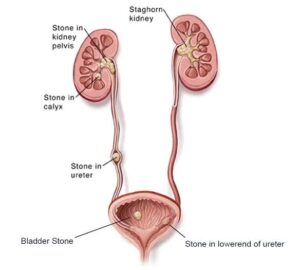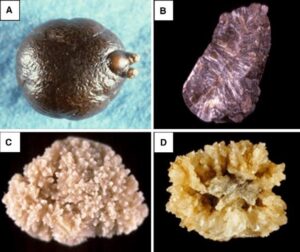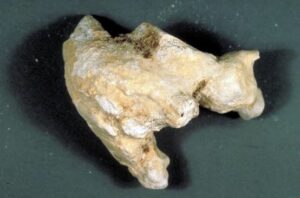RENAL STONES

What do you mean by renal stones?
A Kidney stones, also known as Renal Calculi\ Nephrolithiasis is a hard, solid mass of material that forms in the kidney from the substances in the urine.
Renal stones are one of the most common disorders of urinary tract, which develop as a result of various metabolic disorders which affect the fate of calcium and other mineral elements in the body.
Kidney stones are usually small, but can grow larger in size, even filling the inner hollow structures of the kidney called Calyx. Some stones moves to renal pelvis or into the ureter is called ureteral stones. Stones that fill entire renal pelvis and at least one renal calyces called Staghorn renal stones. There they can lodge, block the flow of urine and can cause pain. The ureter that drains urine from the kidney meets bladder, this junction is called uretero vesicular junction. The stone in the uretero vesicular junction causes the urine to back up into and dilate the ureters and kidney [ Mega ureter and Hydro nephrosis] Stones in the bladder called Bladder stones which may drain out from ureter or may occur when urine in the bladder becomes highly concentrated. When the stones are small sized up to 4mm can pass naturally through urine. Otherwise it may get lodge in the urethra leading to urethral stones.
Types of Renal Stones
- Calcium stones may be either calcium oxalate or calcium phosphate.
Calcium oxalate – oxalate is a substances made daily by our liver or absorbed from diet. Certain fruits and vegetables as well as nuts and chocolates have high oxalate content. Also high doses of vitamin. D , intestinal bypass surgery and severe metabolic disorders can increase the concentration of calcium or oxalate in urine.
Oxalate stones are brown in color with sharp projections.
- Calcium phosphate – phosphate stones are usually occurring in an infected urine. It is smooth and white in color. In an alkaline urine , it enlarges rapidly, filling renal calyces taking their shape called staghorn calculus. It is radio-opaque and attains a large size. This type of stones are more common in metabolic conditions such as Renal tubular acidosis. It may also be associated with certain medications used to treat migraines or seizures such as Topiramate.

- Struvite stones – It is compound of magnesium, ammonium phosphate mixed with carbonate. It forms in response to urinary tract infections. These stones can grow quickly and become quite large, sometimes with few symptoms or little warning.

- Uric acid stones – hard , yellowish , multiple and radiolucent. It can form in people who lose too much fluid because of chronic diarrhea or malabsorption, those who eat a high protein diet and those with diabetes , gout, or metabolic syndromes. Certain genetic factors may also increase your risk of uric acid stones.

- Cystine stones – occur in cystinuria where there is defective absorption of cystine from the renal tubules. It is multiple, soft, yellow in color and the color changes to greenish on exposure. It attains large size. It is radio-opaque because it contains sulphur.

Now as per Siddha concept,
Renal stones are known as Kalladaippu, as it cause obstruction in flow out of urine, it referred as Neerinai arukkal noi. As per siddha kalladaippu is Classified in to 4 types
- Vali kalladaippu
- Azhal kalladaippu
- Iya kalladaippu
- Mukkutra kalladaippu.
Risk factors
- Dehydration
- Increased intake of Protein and Sodium
- Obesity
- Digestive disorders [eg: inflammatory bowel disease]
- Any family history
- Certain supplements and medications [eg: vitamin-C, dietary supplements , excessive use of laxatives, calcium based antacids and certain medications used to treat migraines or depression]
Clinical Manifestations
- Severe pain in the side and back below the ribs
- Pain that spreads to lower abdomen and groin
- Pain that comes in waves and fluctuates in intensity
- Pain while urination
- Cloudy or foul smelling urine
- Nausea and Vomiting
- Fever and Chills if an infection is present
- Urinating small amount of urine
DIET
- Drink plenty of water
- Low salt and protein diet
- Avoid Oxalate rich foods [ eg: spinach, potato, tomato, cauliflower, citrus fruits, chocolates, red meat etc…]
- Intaking vazhai thandu juice, venpoosani chaaru helps in flush out of stones in urine.
- Cooked kuruvai or manakathai rice , vegetables like raddish, vazahi thandu, sirukeerai, avarai, vendai, pasalai kerai, kaasini keerai must include in daily diet.
- Barley rice gruel.
EXERCISES
Pelvic floor exercises, regular exercises helps in flushing out of excess Calcium and other minerals through urine.
Yoga
- Garudasana[Eagle pose]

- Bhujangasana[Cobra pose]

- Pawanamukthasana[Wind relieving pose]

- Danurasana[Bow pose]

- Paschimottanasana[Seated forward bend].



One thought on “Kidney stones – self-care”